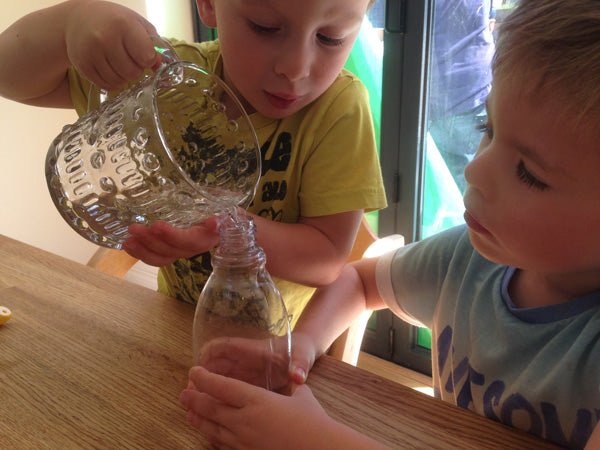Little Explorers: Sea in a Bottle
- Little Explorers

Your Little Explorers might be about to start preschool, or perhaps big school. If so, good luck! It’s an exciting and tiring time for the whole family as they adjust to change. Here’s a wonderfully calming, restorative activity. Create a sea in a bottle and you’ll see those overworked senses soon relax.

Mixing oil and water is a classic preschool activity, but one that bears repeating. It’s easy, quick, educational and really rather beautiful.
You will need:-
- A clear bottle – with a child safe lid if possible
- Vegetable oil
- Water
- Green or blue food colouring

Take your empty bottle and fill it one third of the way up with water. Add several drops of food colouring. We chose green to make the contents of our discovery bottle look like the sea, but you could experiment with other colours, of course!

Ask your Little Explorer to give the bottle a seriously good shake-up. Preferably to the music of Under The Sea if you have it!

Then ask your Little Explorer to fill the bottle up to the brim with oil. Trickle a little glue around the edge of the lid if you’re not using a child safe bottle, and screw it on tightly.
Tip the bottle upside down, and let the magic happen! You can watch the waves crashing around in slow motion inside the bottle. Or give it a very energetic shake and create thousands of tiny bubbles. It’s mesmerising.

Expert Explorers: Do you know why oil and water don’t mix? It’s because oil is a slippery liquid and it doesn’t dissolve in water. When you shake the oil and water it will appear for a moment that the two have mixed, but quite quickly, small droplets of oil will form, then bond with other droplets and on and on, until all the oil has joined in one big mass and settled on the top of the water and the two have separated completely.
The science behind it is that water molecules are ‘polar’ – they have a negative charge and a positive charge at opposite ends. Oil molecules are ‘non polar’ – with no charge at all. So water molecules are attracted to each other. And the oil floats on the water, because, despite appearances, it is actually less dense (and weighs less) than the water!



